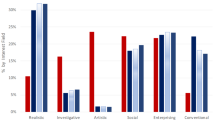Conclusions
The research reported here provides a link between expected mix of job opportunities and labor force participation rates for various demographic groups in the working age population. The model produced statistically significant results, generally, for the expected employment opportunities indices, and appears to be a useful device for analyzing labor force participation changes in reaction to varying employment opportunities.
The empirical results give further evidence of the existence of a dual labor market in which several worker groups, encompassing younger and older workers and non-family heads, are not as strongly attached to the labor force as prime age males. In particular, percentage increases in job seekers in secondary labor force groups induced by expanding employment opportunities may well exceed percentage increases in employment opportunities in an area. These groups' labor force participation elasticities with respect to employment opportunities are usually greater than one, thus adversely affecting attempts to reduce the “official unemployment” problems of these secondary groups.
Given the greater difficulties these so-called marginal or secondary workers have in finding employment, manpower planners need to anticipate shifts in the labor force composition in assessing needs to be met through job creation and manpower programs. In particular, the results suggest that selective job creation and training programs may be necessary to solve unemployment problems.
Finally, this research provides additional evidence demonstrating the inadequacy of unemployment counts to show the total number of persons desiring a job and, thus, the total size of the “employment problem” faced in a labor market. Moreover, the number of hidden unemployed who will became active job seekers as job openings develop is related to the mix of specific job openings as well as to the demographic mix of the population age 16 years and over.
Similar content being viewed by others
References
William Bowen and T. Aldrich Finegan,The Economics of Labor Force Participation, Princeton: Princeton University Press, 1969.
Glen G. Cain, “The Challenge of Segmented Labor Market Theories to Orthodox Theory: A Survey,”Journal of Economic Literature, 14, December 1976, pp. 1215–57.
Peter B. Doeringer and Michael J. Piore,Internal Labor Markets and Manpower Analysis, Lexington, Massachusetts: D. C. Heath and Company, 1971.
Karl A. Fox, “The Emergency of Multi-County Functional Economic Areas as Labor Markets and Commuting Fields,” in N. A. Palomba and E. B. Jakubauskas, eds.,An Interdisciplinary Approach to Manpower Research, Ames, Iowa: Industrial Relations Center, 1968.
Dennis Schiffel and Seymour Goldstone, et al,Changes in Labor Force Participation, Employment and In-Migration in Sub-National Economies, Columbus, Ohio: Battelle Memorial Institute, 1971.
John A. Sonquist and James N. Morgan,The Determination of Interaction Effects, Monograph No. 35, Ann Arbor: Survey Research Center, Institute for Social Research, University of Michigan, 1964.
Michael Spence,Market Signaling, Cambridge: Harvard University Press, 1974.
Kenneth Strand and Thomas Dernburg, “Cyclical Variation in Civilian Labor Force Participation,”The Review of Economics and Statistics, 46, November 1967, pp. 378–91.
U.S. Department of Commerce, Economic Development Administration,Handbook for Economic Development District Organization, 1, Washington: USGPO, February 1968.
U.S. Department of Labor, Bureau of Employment Security,Handbook on Defining Labor Market Areas, (BES No. R-186), Washington: USGPO, March 1960.
Michael Wachter, “Primary and Secondary Labor Markets: A Critique of the Dual Approach,”Brookings Papers on Economic Activity, 3, 1974, pp. 637–80.
Author information
Authors and Affiliations
Additional information
The authors wish to thank the Economic Development Administration and the Bureau of Economic and Business Research at the University of Utah for funding portions of this research. The authors also wish to thank Professor Dan Mitchell, Graduate School of Management, UCLA, for his comments on an earlier version of this paper.
Rights and permissions
About this article
Cite this article
Schiffel, D., Blair, L.M. Employment opportunities and labor force participation. Atlantic Economic Journal 5, 53–60 (1977). https://doi.org/10.1007/BF02300310
Issue Date:
DOI: https://doi.org/10.1007/BF02300310




